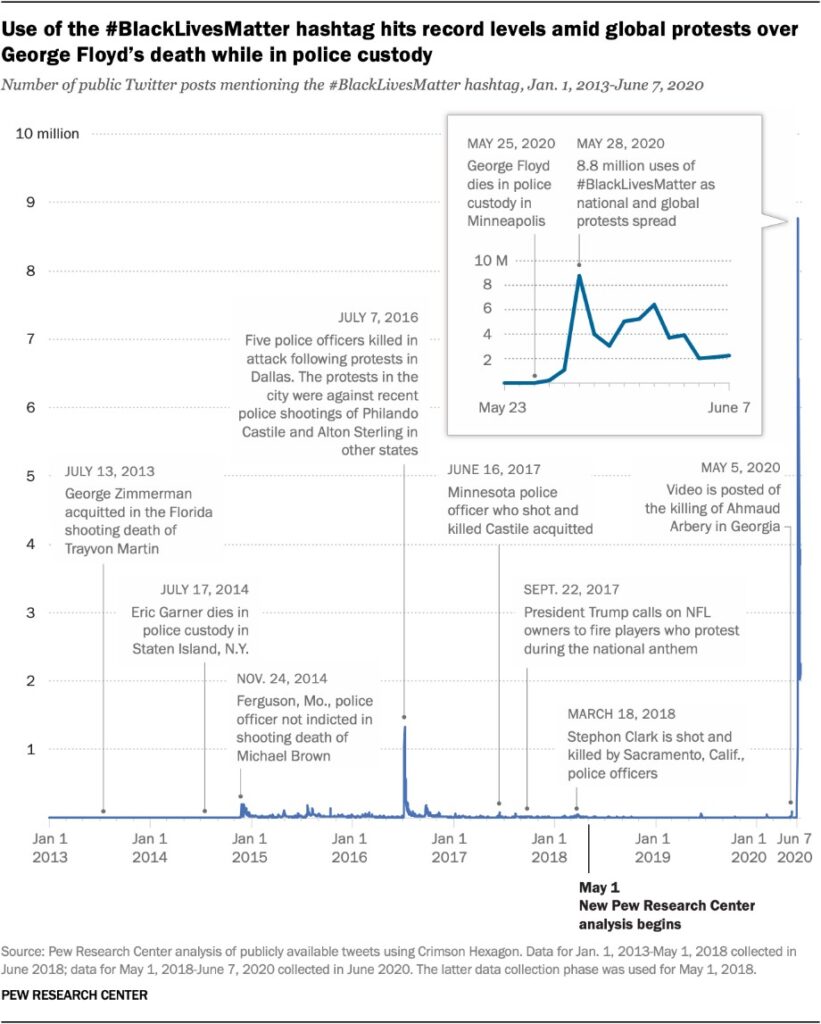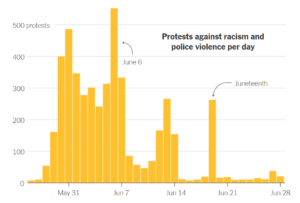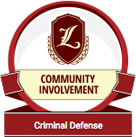- DUI
- Criminal Defense
- Florida DUI
- Traffic Offenses
- Drug Charges
- Marijuana Charges
- Violent Crimes
- Domestic Violence
- Temporary Injunctions
- Weapons Charges
- Theft Crimes
- White Collar Crime
- Juvenile Offenses
- Sex Crimes
- Violation of Probation
- Early Termination of Probation
- Seal or Expunge Criminal Record
- Criminal Appeals
- US Federal Offenses
- Misdemeanor Charges
- Felony Charges
- Co-Defendant Cases
- College Student Defense
- College Student Hearings
- FSU Students
- FAMU Students
- Florida Panhandle Arrests
- Extradition to Florida
- Bench Warrants / Warrants
- Emergency Bond Hearings
- Gambling Charges
- Drone Arrests
- Marsy’s Law
- UAS Infractions
- Introduction of Contraband
- Lying to Police
- Locations
- Case Results
- Our Firm
- Media
- Resources
- Blog
- Contact Us
Social Justice Movements and Social Media
August 23, 2021 Don Pumphrey, Jr. Criminal Defense, News & Announcements Social Share
How Twitter Played a Role in the Black Lives Matter Movement of 2020
Social justice movements have been a part of the human experience for decades. When people feel distressed or dissatisfied with a current law or global situation, groups of people have come together in face-to-face protests around the world. From the Civil Rights Movement in the 1950s and 60s, to the Women’s March and #MeToo movement that we have witnessed in more recent years. So, what exactly is a social justice movement? What is it that brings people together? And how has modern technology played a role in more recent social justice movements?
In the summer of 2020, the world was at a standstill due to the lockdowns imposed from the COVID-19 pandemic. As if that wasn’t stressful enough, the United States saw an uprising of hatred and mistreatment of Black Americans. Although the Black Lives Matter Movement had been well established since its birth in 2013, the summer of 2020 saw its biggest impact across America. The public video of George Floyd’s death surfaced on the internet, and suddenly the hashtag #blacklivesmatter spread like wildfire.
Previous Research on the BLM Movement
The first relevant study from Pew Research Center covered all of the different peaks of the hashtag #BlacklivesMatter over the time span of 7 years, from 2013-2020. This study pinpointed the various incidents that created spikes in the hashtag use. The newest provided data shows the spike after George Floyd’s death. On the day of May 28th, 2020, there were 8.8 million tweets using the hashtag #Blacklivesmatter. This was the hashtag’s highest day ever recorded on Twitter.

An additional study that focused on the 2020 Black Lives Matter protests came from a New York Times article, with a collaboration with a Texas State University professor and Crowd Counting Consortium—a data collector on crowd sizes at a political protest. This particular study analyzed the number of attendants at BLM protests for over a month, and concluded that June 6th was the day with the largest number of protestors across the US during the entire summer. These numbers also indicated that the BLM movement could potentially be the largest movement in the history of the United States. One Stanford professor was quoted, “It looks, for all the world, like these protestors are achieving what very few do: setting in motion a period of significant, sustained, and widespread social, political change.” The article also gives credit to the BLM Movement, claiming that the use of social media is providing guidance and information on materials by quickly sharing protest details to a wide audience. That a framework for new activists is created without necessarily directing each individual protest.

Background on Social Justice Movements
A social movement is a network of informal interactions between individuals, groups, and organizations engaged in political or cultural conflicts. This is based on shared collective identities. The social construct of a protest takes place between groups and social categories within social networks. Within a social movement or a protest, there are different characteristics that come into play. This includes the actors, resources, culture and collective identity, and mobilizing structures.
- Actors – The actors are those who are the main leaders of a movement, or the face or branding. For the Civil Rights Movement, Martin Luther King Jr. and Malcom X would be considered the major actors of its period. In modern times, it is not always so common to have just one face attached to a movement. In fact, the use of social media provides the ability for the “actor” to be anyone who is participating and pushing forward the ideology of the social movement. With the Black Lives Matter protests, anyone using the hashtag #Blacklivesmatter could be considered one of the actors.
- Resources (Time and Money) – When referring to a social justice movement, the two most important resources are time and money. Money is included in the cost of putting together campaigns, signs, and most importantly, buying more time. This would have been a major stress on social movements in the past, where people needed to try and gather donations to keep the movement rolling. However modern technological advances provide a leniency for resources. The global reach that social networking sites (Twitter) create with just one touch of a button is a huge advantage for social justice movements. Campaigning for an organization or social movement becomes quicker and cost-free. With the BLM movement being created during a time when Twitter already existed and was well recognized across the globe, it helps to explain how the movement has seen so much traction since its birth.
- Culture and Collective Identity – Culture is the ideas, belief systems, and rituals that are all central to social justice movements. When people come together to support the same ideology of a culture, a collective identity is created. Most social movements have been shaped around different cultural groups, including the LGBTQ+ community, the Women’s March, and the Black Lives Matter community.
- Mobilizing structures – Mobilizing resources and mobilizing structures can relate back to ideology on a specific topic. Like culture, this encompasses beliefs, values, and meanings that help motivate people to participate in social justice movements. Ideology can help to transform dissatisfaction into politicized agenda, providing a sense of collective identity, and serve as a movement resource.
The Black Lives Matter Movement
One movement that has recently spread globally was the Black Lives Matter Movement. Although it has been 40 years since the conclusion of the Civil Rights Movement, there is continued violence and oppression towards Black Americans, which has incited the new social movement known as the Black Lives Matter Movement.
The movement began with a hashtag that was created on Facebook in 2013. George Zimmerman’s acquittal sparked frustration from the hashtag’s creators—Alicia Garza, Patrisse Cullors, and Opal Tometi. What started as an open letter to write out their frustration towards the violence inflicted on Black communities turned into the beginning of a worldwide movement.
The Black Lives Matter Movement can be described as a grassroots movement, meaning using people in a community as the basis for political or economic change. Grassroots movements use collective action from the local level to effect change at the local, regional, national, or international level. Along with providing helpful resources through their website, the Black Lives Matter Movement functions as a vehicle for social justice movement. In addition, the BLM Movement was credited in Time’s 2015 Person of the Year as the runner up, with the statement: “Black Lives Matter is anchored in the physical occupation of public space and amplified by social media.”
Social Media and Twitter
One of Twitter’s most unique characteristics against other social network platforms is its use of hashtags. Hashtags categorize messages, and are able to build internet based communities based on one topic of interest. Hashtags can be seen as democratic in the way that anyone is able to use them. When it comes to social justice movements, hashtags can play as a substitute for physical presence of participants. With the 2020 BLM protests occurring throughout the COVID-19 lockdowns, it highlights just how important of a role online protesting became. The rapid fire spreading of the hashtag #Blacklivesmatter not only got the world talking, but eventually led people into the streets regardless of the current pandemic situation.
Connective action is what truly brings together social justice movements and social media. Connective action is the action taken by individuals in pursuit of a common goal or collective good. At the core of connective action is the recognition of digital media as organizing agents. In this sense, Twitter can be credited with creating a new form of connective action for social justice movements. This mobilization revolves around hashtags, memes, and personalized action frames. The differing mechanisms utilized include weblinks for organization donations, event coordination, and resource information sharing. By inciting social justice movements through social network platforms such as Twitter, information flows freely and easier.
Although the BLM protests are no where near the numbers they held in summer 2020, it is by no means over. There have also been other social justice protests spreading around the world within the last year. It is important to view how we continue to stand up and protest what we believe is right, and how technological advances can help generate change across the globe.
Florida’s Reaction to Social Justice Movements
After a summer of protests in the wake of George Floyd’s murder, Gov. Ron DeSantis has signed for the Anti-Riot Bill to prevent any violent protests. Protests could now be deemed as “mob intimidation” which equates to a first-degree misdemeanor with up to one year in prison. If a protest is classified as a “riot” it is considered a second-degree felony and has a penalty of up to 15 years in prison. The new law would prevent protestors from posting bail until after an initial court appearance. Any damage to a historical monument will be classified as a third-degree felony and is punishable with up to 5 years in prison. In addition, the anti-riot law grants defense to those who potentially injure or kill protesters with a vehicle and would excuse them from criminal liability.
Gov. DeSantis has received backlash from the anti-riot bill, arguing that peaceful protestors could possibly be arrested and held without bail, or even charged with a felony just for participating in an otherwise peaceful demonstration. Some Florida representatives expressed that it feels like it is going several steps in the wrong direction. Trying to march for systematic changes, only for the other side to push back and try and silence the voices. As it is a First Amendment right for freedom of speech, it is vital that citizens can continue protesting what they are dissatisfied with, whether it be in person or online.
If you want to read more about Florida’s anti-riot bill, you can read more about it on our specific blog post here.
This article was written by Karissa Key










